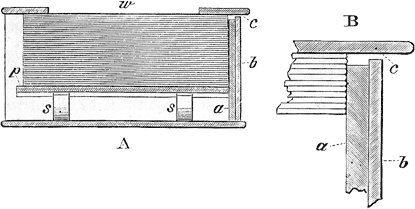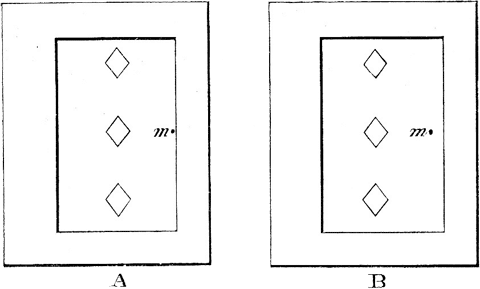
|
foreword to the online edition I. introductory II. common sharpers and their tricks III. marked cards and the manner of their employment IV. reflectors V. holdouts VI. manipulation VIII. the game of faro IX. prepared cards X. dice XI. high ball poker XII. roulette and allied games XIII. sporting houses XIV. sharps and flats
|
SHARPS AND FLATS
CHAPTER VIII THE GAME of FARO
The Sand-Tell Gaffed Faro BoxThe box with which these cards are used is shown in fig. 41, which represents a section taken through the centre of the box, from top to bottom. Referring to 'A' in the illustration, s, s are two of the springs which press upwards upon the partition p, this in turn keeping the cards tightly pressed against the top of the box, in which the aperture or window w is cut. These details are of course common to all dealing-boxes, as already explained. The trickery, however, in this instance is in connection with the front side of the box. Instead of being of an equal thickness all round, the front is made double. That is to say, an additional plate of metal is put inside the box, covering the whole of the front plate, except that it does not reach the top by the thickness of two cards. 'B' in the illustration represents an enlarged sectional view of the mouth of the box. The additional plate is shown at a; b is the normal thickness of the front, and c is the slit through which the cards arc pushed out. The prepared cards being put into a box of this description, the effect produced in dealing is as follows. If the third card from the top is one of those which has been roughened on both sides, the second card will adhere to it; consequently the act of drawing off the top card will not cause the second to alter its position in the box. If, however, the third card should happen to be one of the tell-cards, whose face has been left smooth, the top card will draw the second one a little distance to the right over the top of the plate a. The second card, however, cannot be drawn right out, because the slit c is not wide enough to allow more than one card to pass at a time. It is obvious, then, that if the players have some means of knowing whether the second card moves or not, they can tell whether the card immediately underneath it is a tell-card or the reverse. On reference to the illustration it will be manifest that the actual distance moved by the second card when drawn aside in this way can only be very slight. Indeed, it would not do to allow of much movement, or the dealer might notice it. Therefore, special means have to be adopted to enable the sharps to detect the small difference in the position of the cards. The necessary indication is readily obtained by means of what are known as 'sighters.' These are simply minute dots upon the faces of the cards. Upon each card one of these dots is placed, in such a position that when the card conies to the top the dot will be close to the edge of the aperture, but if the one below it is a smooth or tell-card, the slipping sideways of the card brings the dot away from the edge, and it appears farther to the centre of the opening. Fig. 42 is a diagram representing the top of a sand-tell box under both conditions. The dot marked m is the sight. In practice, it is much finer than here shown, being in fact only just visible. 'A' indicates the position of the dot when the card below happens to be one which has been roughened. 'B' shows the card drawn to one side, bringing the dot away from the edge, thus intimating the fact that the card immediately underneath is a tell-card, the face of which has been left smooth.
FIG. 42 The general practice is to make all the court cards 'tell.' The advantage thus gained is that it is not necessary to bet on any particular card, but simply to back the high cards to win and the low ones to lose, or vice versa. This is not so liable to cause suspicion as having all the aces, for instance, to tell. In a case of this latter kind, the slipping of the card would indicate that the next card to be revealed would be an ace; therefore, if the conspirators are to win, at least one of them must bet upon an ace turning up. Whereas, if all the picture cards are made to tell, not only are there more tell-cards in the pack, but it is only necessary for one player to bet upon the high cards generally. The box simply tells them that a high card will show next, and they make their bets accordingly.Of course, it would never do for all the players to stake their money alike. That would let the cat out of the bag, with a vengeance. No; if the next card is to be a high card, one of them will bet upon the high cards; the others will bet upon particular small cards, avoiding the high ones. They cannot possibly lose on the next card, because they know that it is not one of the low cards which comes next. It will be remembered that, in the description given of the game, we saw that the bets are made just before the dealing out of each pair of cards or 'turn.' Therefore the indication given by the tell-box is only of use to the players before a turn commences, that is to say, before the first card of the pair is shown. They cannot change their bets until the second card of the pair is shown and the turn is played. Therefore, supposing the box indicates that the first card of the next turn, the one that wins for the players, is a court card, and that one of the players has consequently backed the high cards, the others must be careful how they arrange their bets. It may happen that one of them has put his money upon a card which will be the next to turn up; and this being the one which wins for the bank, that stake will be lost. Therefore, they have to arrange matters so that the highest stake which can possibly be won by the dealer is less than that of the player who has staked his money upon the card or cards which they know will win on the first draw. Or it may be that the other players will 'copper' their bets upon the low cards and thus play for absolute safety.
These manúuvres are necessary, and are here pointed out because they may be of assistance as a guide to the investigation of suspected cases of cheating by the means just described. If it should be found that, in a game of faro, it constantly happens that one of the players not necessarily the same player always wins on the first card of a turn, and that on the second card the others either do not lose at all, or, at any rate, that the amount which either of them loses is less than that which the other has won, it may bo safely inferred that cheating is in progress.
|
| « the game of faro (cheating) | the game of faro (needle-tell box) » |
home | introduction | book content | links | advertising | contact

